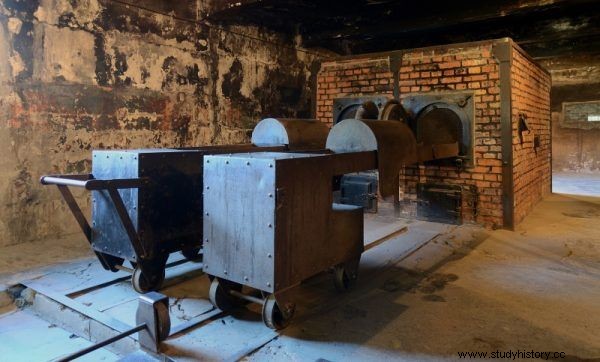This practice rose to heights of disgustingness. Nazi degenerates set up a gold mine in Auschwitz, although they did not use a single pickaxe for this purpose.
Every day, behind the barbed wire of the Auschwitz German death camp, people were stripped of their dignity and… the remnants of the property they took with them when they set out for the unknown in cattle cars. Shortly after arriving at the infamous ramp, during the selection, everything was to be taken from them, and special commandos were going through their clothes and luggage with skillful movements.
Those who took their clothes with sewn up valuables and documents, and then had their heads shaved, their camp number tattooed and dressed in striped uniforms, could consider themselves… lucky. They were alive.
Meanwhile, those who were directed to the "showers", where instead of steam they were enveloped by the vapors of the poisonous Cyclone-B, they died in cruel torments. It was not the end of their ordeal. Before their convulsed bodies were removed, they ended up in a crematorium or in an ordinary ditch, where they were to be burned, one more stop was waiting for them.
The first mass transport of prisoners to the camp arrived on June 14, 1940. As we can read in the volume devoted to the lives of prisoners published by the Auschwitz-Birkenau state museum:
As early as September 23, 1940, Himmler ordered the removal of gold dentists (Zahngold) from the teeth of prisoners who died in concentration camps.
Golden "output"
The Auschwitz crew eagerly set to work. Among its ranks was Victor Capesius, the camp pharmacist . The Volksdeutscher, who came from Romania, was kind of "lucky" that in the pharmacy he managed there was an office of the main camp dentist, through which all the disgusting "waste" was to pass.
All because of a greedy SS man who stole a suitcase full of gold teeth in 1943 and escaped. From that time on, the Nazi authorities began to look much more carefully at their potential profits. The statistics show that the game was definitely worth the candle from their perspective.
As Capesius biographer Patricia Posner says in the book “The Pharmacist from Auschwitz. The story of an ordinary criminal ” :
The scrap of dental gold from the cadaver, as well as gold coins, watches, cigarette cases and jewelery items taken from the arriving prisoners, were pre-smelted. The Nazis in Auschwitz obtained, on average, from 29 to 34 kg of gold a day. It was a source of enormous profits for the SS. Shipments of gold stamped as coming from "Auschwitz" began to reach the Berlin headquarters of the Reichsbank [...] as early as 1943.
We will never know exactly how much gold the Germans obtained in this way. The records containing this information were seized by the Americans after the war. Although after some time the documents were transferred to the West German archives, then they were ... "removed as part of cleaning work".
In any case, there was an extremely efficient production chain in the camp, allowing the most effective recovery of ore from battered corpses. As quoted by Posner in the book “The Pharmacist from Auschwitz. A story of an ordinary criminal ” prisoner Jakov Gabai, this hideous practice was initially dealt with by real dentists from Czechoslovakia. The men were pulling out gold teeth and tossing them into a large box marked "Germany".
When the specter of a lost war and the arrival of Soviet troops loomed over the camp, the commandant ordered the efforts to be intensified. Therefore, a commando of prisoners was forced to work and they simply tore the gold from the corpse with pliers. They had to work quickly and brutally, so the ore ended up in crates along with fragments of jawbones or scraps of meat.

Crematorium in Auschwitz. Before the bodies of the murdered were brought here, specially delegated prisoners had to check whether their bodies had even a gram of gold left (photo Marcin Białek, license CC BY-SA 3.0)
He robbed prisoners and ... the Third Reich
Capesius engaged prisoners under his control to sort these gruesome treasures. Up to a hundred suitcases full of human teeth have been seen at any one time in the pharmacy building. Inevitably, before the prisoners could smelt the gold from them, the fragments of flesh began to decompose, so that the rooms were unforgivingly stench. Undaunted, the chief pharmacist was wading his hands through his teeth and picking out the larger pieces, as if judging how much he would earn from them.
Capesius, who appointed prisoners to smelt the gold, was content to weigh more bars in his hands. The camp dentists, his colleagues, were his accomplices in the theft of corpses. Everyone plundered not only the victims, but also ... the Third Reich. Kruszec was supposed to go to the Reichsbank, while Capesius and partners took some for their own needs.
The pharmacist sent his fare to his sister in Vienna. After the war, when he managed to excuse himself from the responsibility for murdering prisoners and served an absurdly low sentence, he reached for his gruesome treasures, stored in Austria for a rainy day. Thanks to them, he managed to open his own pharmacy and drugstore, and he calmly lived to see his days.
Read also the article about the profile of the camp pharmacist Capesius. And if you want to know more:we recommend his latest biography.
Source:
Trivia is the essence of our website. Short materials devoted to interesting anecdotes, surprising details from the past, strange news from the old press. Reading that will take you no more than 3 minutes, based on single sources. This particular material is based on the book:
- Patricia Posner, Pharmacist from Auschwitz. The story of an ordinary criminal , Publishing House of the Jagiellonian University 2019.
